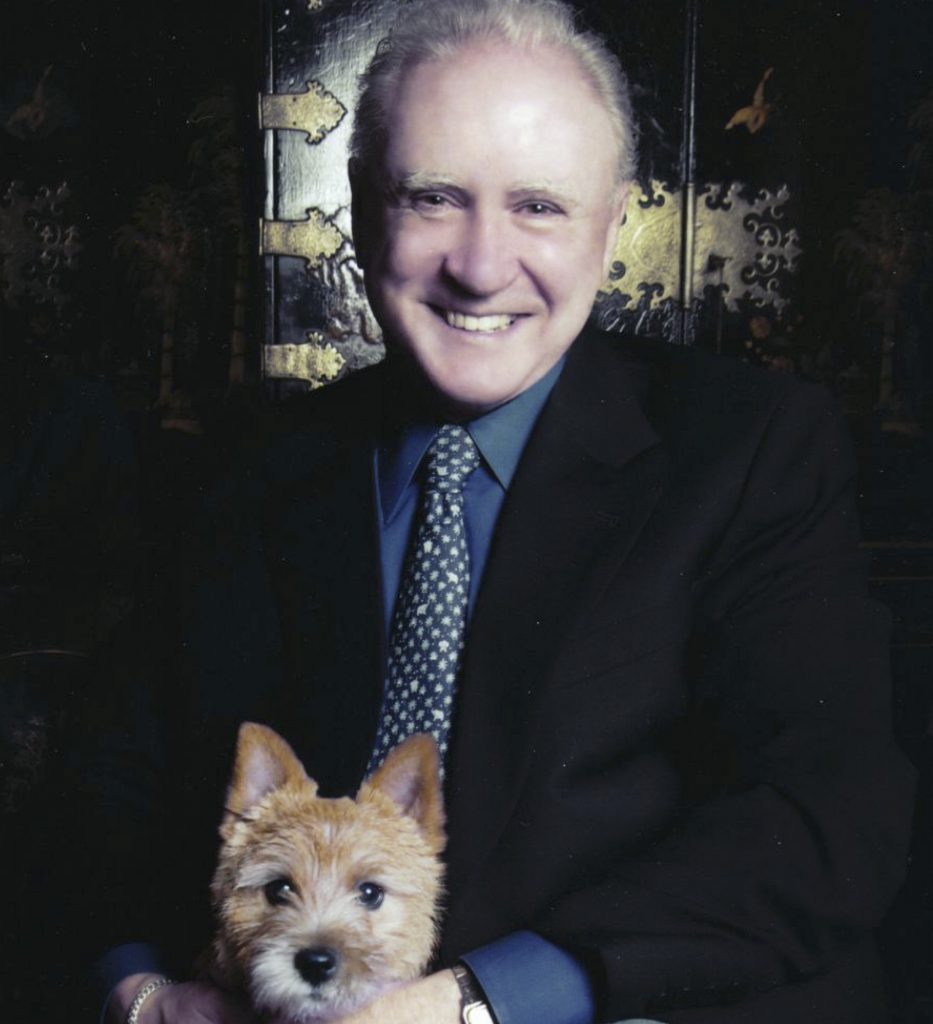618 – Pro Tips on Changing the Conversation from Ian Lynch
Pro Tips on Changing the Conversation from Ian Lynch
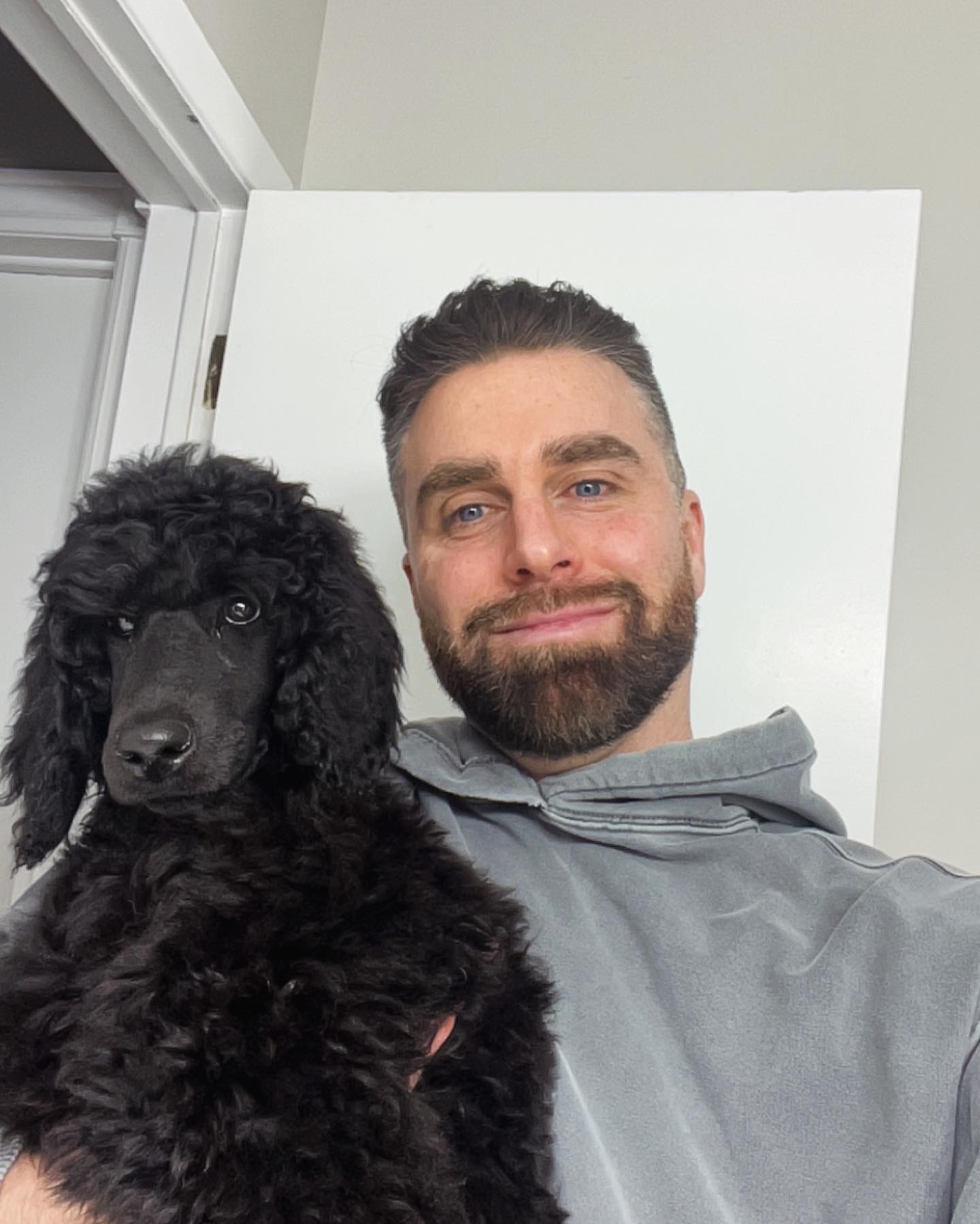
Ian Lynch with his newest Dawin Poodle, Portia.
Canadian Kennel Club spokesperson Ian Lynch joins host Laura Reeves to talk about changing the conversation on purebred dogs with the general public.
Lynch, a broadcaster in his day job, brings his passion for purebred dogs to the CKC as their public spokesman. He describes his lifelong obsession with the sport, obtaining the Dogs in Canada Annual magazine and creating a “vision board” with pages from the book taped to his wall.
His first dog as an adult was a Dawin standard poodle.
“I used to get “Dogs in Canada” annuals and I used to put all the pictures on my walls because I love these dogs. And I had a picture on my wall in 1995. It was an Allison Alexander in a red dress, holding Dawin High Falutin, who was the number one dog and has all these records to this day. His name was Lutin, I believe his call name. And it’s funny because as I get older, I realized that I was making a vision board because now I have a Dawin dog.
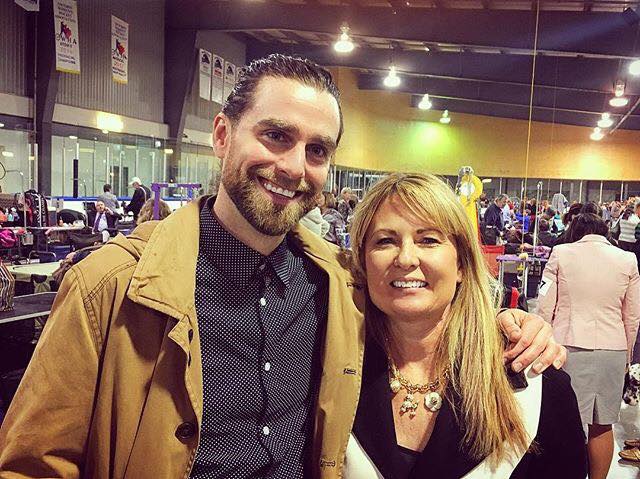
Ian Lynch and Allison Alexander, from vision board to friends.
“And I’m friends with Allison Alexander and she’s the greatest person alive. So, it’s so funny that like, you know, that you hear almost like manifestation stuff and I didn’t know what I was doing. But as a kid, I used to always have the picture of the Dawin dog and I used to tell my parents, ‘I’m gonna have a dog just like that one day.’
Don’t just talk. Listen!
Lynch recommends we just talk to people about dogs. And not just talk, listen also! On topics from training to doodles, listening to what people say gives you a chance to address their actual concerns and increase buy in to the information you do have to share.
“The easiest way for me, I think, to start talking to people about purebred dogs is to talk to everyone who has a dog.
“For example, there’s this lady on my street. She has this pitbull mix. And this dog was so reactive to my dogs all the time. I mean jumping in midair. And then, I noticed that from a distance, she taught the dog the look at me, you know, the treat out. And I stopped her and I said, ‘Sorry to bother you, I just want to congratulate you and let you know that I’ve noticed how good you’re doing with this dog and how far your dog has come.’ And she says to me, ‘Oh my God, thank you. I’ve always admired your dogs. What kind of dogs are they? Are they show dogs? Where are dog shows? Where can I learn more about these dogs?’ Simply talking to people about dogs.
“The way I think a lot of times, I’m lucky I have a radio show. I can infuse dogs. I got the mic. I got the platform. But we can all infuse dogs into our life at all times. When you have people over, my dogs are generally always well-groomed and bathed, basically weekly, but you want to make sure your dogs will look good if people are coming over.
“They smell good, they’re cuddly. I’m a big proponent of best self and make sure your dogs are their best self when people come over and, you know, people ask questions. Another thing we have to do is when we talk to people about dogs is we have to let people talk as well.
“We know a lot about dogs. We want to voice our opinions, but we have to let people talk.”
369 – Judges Share View from the Center of the Ring
Judges Share View from the Center of the Ring
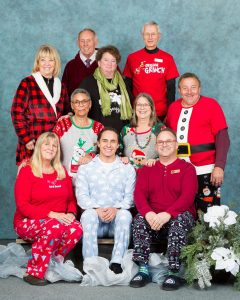
The Prairie Christmas Dog Show judging panel on “pajama day”…
These judges share their 411 stories and their views from the center of the ring. This is part one of two from our panel discussion at the Prairie Christmas Dog Show in Regina, Saskatchewan.
Our panelists share common paths to involvement with purebred dogs. Frances Smith talks about family connections and, bonus, the story of transporting Yorkshire Terriers from England to Argentina by ship. Obedience competition that started with a mixed breed dog brought obedience judge Diana McKenzie to purebred dogs. Sue-Ellyn Rempel talks about coming to dogs from horses.
You only get one chance to make a first impression and these panelists agree it really is a critical piece to judging.
“I want to see type, quality, balance, and to know a dog is a dog, a bitch is a bitch,” Smith said. Rempel agreed, noting outline, angles and breed type are her first look.
McKenzie added that she wants to see that each handler-dog team to be a really a *team.*
Making the picture becomes a critical piece of success, as each judge has a picture in their mind of a “perfect” one of each breed.
Essentials of type
“Many people don’t exactly know what type is,” Smith observed. “Type is the essence of a breed. It’s what makes each breed unique and different from another.” Smith’s clear and concise definition of the six factors of type is magical.
The six elements that define each breed: head, color, size/measurement, temperament, coat, movement.
“Movement is breed specific. Temperament is type,” Smith said.
Applying breed type to obedience performances, McKenzie offered a fascinating perspective.
“With different breeds in obedience competition, you still have breed type,” McKenzie said. “Different dogs sit differently and at different speeds, for example. How straight they are affects score. Just because you’re fast doesn’t mean you’re going to be good. Sometimes slower workers are more precise workers.”
282 — John Reeve-Newson: Be Kind and Show Good Manners
John Reeve-Newson: Be Kind and Show Good Manners
John Reeve-Newson graduated from the Ontario Veterinary College in 1964 and soon after that returned to Toronto to establish The Animal Clinics One and Two, where he is still in active practice. He was also the founder of the Veterinary Emergency and Referral Clinic Partnership of Toronto, the first veterinary emergency clinic established in Canada.
In 2006, Reeve-Newson founded the Companion Animal Wellness Foundation, a registered charity that provides funding assistance for the treatment of the critically ill or injured pets of those financially disadvantaged. In 2014, he was made a Companion of the Order of Caring Canadians by the Governor-General.
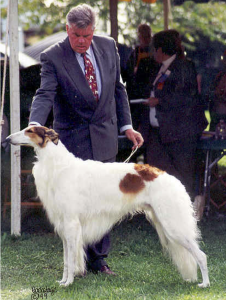
Richard Meen and Am. Can. Ch Kishniga The Tempest, “Sebastian”
With Dr. Richard Meen, they established Kishniga Kennels in 1971. In 1977 Ch. Kishniga’s Desert Song, a Borzoi, bred by Reeve-Newson and Meen, and shown by Meen, was Canada’s top dog all breeds. The following year “Moustache,” as he was called, was exhibited in the USA and was number two hound in the USA. He is still the record holder for the breed with forty-seven all breed BIS in Canada and the USA to his credit. His brother “Dalgarth” was the youngest of his breed to win a BIS, which he did at nine months of age.
As a judge, Reeve-Newson remembers how he was treated as a newcomer and endeavors always to be polite and respectful of all exhibitors and dogs.
“Even if a dog isn’t good, (the dogs) don’t know it,” Reeve-Newson said. “They deserve as much of your attention as a great dog. They deserve to be treated with manners and politeness.”
Reeve-Newson will be judging at the World Dog Show in China next week. While the show venue has received criticism, Reeve-Newson believes in leading by example.
“You’re not going to change anything unless you go and show them a good example,” Reeve-Newson said. “Staying home yapping your mouth off isn’t going to do any good.
274 — Pam Bruce: Crime Scene Investigator and Dog Show Judge
Pam Bruce: Crime Scene Investigator and Dog Show Judge

Pamela Bruce, Canadian and AKC judge.
Canadian and AKC judge Pam Bruce recounts her background working as a police investigator for the elite Special Victims Unit in Toronto in part two of her interview with host Laura Reeves. Bruce, a cancer survivor herself, (10 years ago in April she was given three weeks to live) reminds us that dog shows are not curing cancer or solving world peace.
Dog people are fascinating
Bruce was a real-life Mariska Hargitay in Toronto. Her professional life and dog life frequently intertwined in cases in which Dr. Richard Meen (CKC/AKC judge and long-time breeder) was called as an expert witness in cases dealing with young offenders in which she was the lead investigator.
“When I first came on (police work), there was a horse and a woman assigned to every platoon,” Bruce said. “Women were assigned to strip searches, sex assault and child abuse cases. They gave us the janitor’s closet to change in.”
Bruce spent only a year in uniform. Fascinated by sex offenders and dangerous offenders, she went back to school and specialized in DNA.
In another dog show and professional crossover, Bruce finds her “resting bitch face,” while useful in interviewing dangerous offenders, comes across as stern in the show ring.
“I learned it in interviews,” Bruce said “because you’re going in with dangerous offenders – all male – who know they can take you on physically, but are really interested in taking you on mentally.”
Do the research
“I am frequently shocked by the fact that exhibitors don’t know who they’re showing to. They don’t do their research to find out what the judge’s background in dogs is,” Bruce said.
“I have never once enabled anyone to speak badly to me about any dog,” Bruce noted. “And I’ve never denied a dog based on who’s on the leash – it doesn’t work that way.”
Listen to part one of the interview from last week.
262 — Will Alexander on Grooming, Handling and Heroes
Will Alexander on Grooming, Handling and Heroes
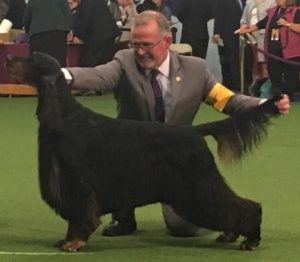
Will Alexander winning BOB in Gordon Setters at Westminster Kennel Club this week.
Canadian dog handling legend, Will Alexander, shares his memories, his handling tips and grooming tools that have brought him significant success in the last 25 years.
“My heroes were people like George Alston,” Alexander said. “He basically taught me to trim Irish Setters over the phone.”
“I always wanted to be a handler, but before embarking on a handling career I worked for Garry MacDonald in Canada, and for Bobby Stebbins in the States,” Alexander said.
Carving the picture
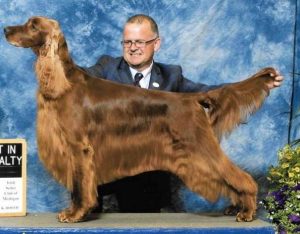
Will Alexander grew up with Irish Setters and learned from George Alston, over the phone, how to trim them.
Grooming is not a recipe, Alexander noted. Every dog is different. Famous for his meticulous grooming of setters particularly, Alexander describes a process to “build a shell around the dog” when trimming the back coat. He works with a stripping knife, his fingers, a grooming stone and, the most important piece, a bristle brush to bring up the oils in the coat.
Attention to detail
“I hate it when I hear “Oh, they won because they are so and so… well, they didn’t just grow up and they were so and so… they had to work hard to become so and so,” Alexander said. “It’s hard work. For every 15 minutes of fame there are 23 hrs 45 minutes working on your dog. It’s not age, it’s mileage.”
Tips of the trade
- Think in slow motion. In real time you’re doing exactly the right speed.
“When Miss P won the group at the Garden, George Alston called and yelled at me that I had gone too fast on the down and back. It was terrifying!”
- Attention to detail.
“I like to sit and watch the ring, pretend I’m in there already, making my mistakes in my head so I don’t make them in the ring.”
- “Old fashioned” isn’t bad
“I have a mind’s eye picture of the dogs. So much of type is in how they move, how they carry themselves,” Alexander said. “We need to be preserving the breeds not ‘improving’ them.”
Dream Best in Show Lineup
- English Springer Spaniel Ch. Salilyn’s Condor
- Borzoi Ch. Kishniga’s Desert Song
- Doberman Pinscher Ch. Brunswig’s Cryptonite
- Wire Fox Terrer ch galsul excellence
- Pekingese Ch. Wendessa Crown Prince
- Standard Poodle Ch. Rimskittle Ruffian
- German Shepherd Dog Ch Altana’s Mystique
BIS to Robert the Springer
For more information, videos, the book and more, visit http://www.doghandlingtips.com/



